The Legend of Zelda: The Minish Cap is a video game released in the year 2004, and is the twelfth game

The Legend of Zelda: The Minish Cap
released in the Legend of Zelda franchise.
Hyrule[]
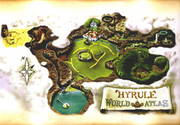
Hyrule Map
While certain landmarks of Hyrule commonly return, Hyrule's geography appears to be laid out differently with almost every new game set in it. Parts of Hyrule found in one game's map may be in a different location, have different geographical features, or be completely absent in another. While some games may take into account the geography in past Zelda games (A Link to the Past and Four Sword Adventures share almost the same Hylian geography) others may completely ignore them (The Minish Cap's Hyrule bears almost no resemblance to any other game). Several fan explanations have been given. The first is that the changes occurred because of geological events between the games such as earthquakes, mudslides, erosion, forest growth, continental drift, or all of the above. The second theory is that Hyrule's geography stays relatively the same but that each new game shows the same Hyrule seen from a different angle, that landmarks are renamed, or that other unseen parts of Hyrule are seen each game.
Some fans argue that while Hyrule does change from game to game it is simply due to gameplay reasons

Hyrule Map
to give players something new to explore while staying in the same land and has no real in-game explanations.
It is also possible that different parts of Hyrule are shown throughout the various games. In The Legend of Zelda comics, the map from Zelda II: The Adventure of Link is added to the north of the map found in The Legend of Zelda, and the in-game map for Zelda II: The Adventure of Link also has an area that resembles a scaled down version of the map in The Legend of Zelda. The geography then allows the map from A Link to the Past to be included to the west.
Sheikah[]
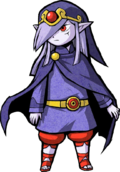
Vaati is a recurring villain of the Four Swords subseries. This character, although he is of the Minish race, has the red eyes and pointed ears of the Sheikah. Also, in most of his "monster" forms he assumes the appearance of an enormous eye. In the The Legend of Zelda: The Minish Cap, his penultimate transformation (Vaati Transfigured) has the eye and the three triangles/eyelashes, resembling the Sheikah symbol.
Cloud Tops[]
It is possible that Ezlo's powers allow Link to walk upon the clouds, for both of the
Cloud Tops
Hailey and her sister, show surprise that Link is able to walk on clouds.
With the events of The Legend of Zelda: Skyward Sword in mind, it is also possible that the Cloud Tops could be the remnants of Hylia's Cloud Barrier, and the Palace of Winds a repurposed section of Skyloft.
The Wind Tribe may also be linked to the Oocca and their City in the Sky, perhaps being their human ancestors, alhough it is unknown if the Oocca already existed by this time. Alternately, both civilizations may exist concurrently and simply be unaware of each other, although given Siroc's claim that she knows much from listening to the wind, this is questionable.
Darknut[]
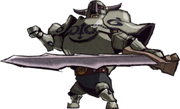
Darknut
It is possible that the Japanese for Darknut, タートナック (Tātonakku), was intended to represent the English words "Dark Knight," especially considering the nature of the enemy in question and Japanese conventions for representing English with katakana. The localization team may not have realized what the katakana was attempting to borrow from English, with the series recycling the original mistranslation throughout the games rather than correcting it. However, this raises the question of why ダークナイト (Dākunaito) was not simply used instead, as it more accurately represents "Dark Knight" phonetically.
It should also be noted that Darknut and Iron Knuckle アイアンナック (Aiannakku) share the same katakana ending. This poses further questions as to the translations of both names: Darknut could have been "Dark Knuckle", and Iron Knuckle could have been "Iron Nut" or "Iron Knight".
Gregal[]
It is possible that Gregal is married to Siroc, as they are the two oldest members of the Wind Tribe, and the

Gregal
others all seem to be related.
Hero of Men[]
The Hero of Men is a character mentioned in The Legend of Zelda: The Minish Cap. A legendary hero
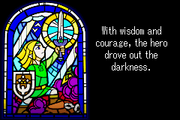
Hero of Men
that saved Hyrule from evil during an ancient conflict known as the War of the Bound Chest, he was the first wielder of both the Picori Blade and the Light Force (having received both from the Picori/Minish), using both of them in unison to lock the Army of Evil away within the confines of the Bound Chestspoken of in Hylian lore. Sealing the chest with the Picori Blade itself, the Hero of Men passed on into legend over the generations and his deeds were still spoken of in songs and tales at the time of The Minish Cap. His true identity remains presently unknown, although he bears a remarkable resemblance to Link himself without his signature cap in the stained glass window images of him in theElemental Sanctuary.
Theory[]
The true identity of the Hero of Men is hotly debated amongst fans of the Legend of Zelda series, and currently there seem to be only two theorized candidates for his true identity, both seen in The Minish Cap. Since he held the Light Force though, it is thinkable that he was a member of the Royal Family.
King Gustaf[]
King Gustaf was an ancient King of Hyrule countless ages before the events of The Minish Cap. In the game, his spirit returns to provide Link with the necessary Kinstone Piece that is required to access the Cloud Topsand thus reach the Palace of Winds where the Wind Element resides. Gustaf was alive around the theorized time that the War of the Bound Chest took place and thus is one of the few characters seen in the game that would match a description of the Hero of Men, provided he is seen at all within the game beyond the stained glass windows in the Elemental Sanctuary. Evidence to support Gustaf's candidacy as the Hero of Men includes:
- Gustaf was alive "countless ages ago", when the War of the Bound Chest was theorized to have occurred.
- He possessed the key Kinstone Piece necessary for one to retrieve the Wind Element from the Palace of Winds.
- He was obviously well-respected and influential even in isolated groups such as the Wind Tribe.
- He was featured prominently over all other former rulers of Hyrule in The Minish Cap.
- King Daltus' figurine states that he himself (a descendant of Gustaf) was a great swordsman in his youth and even fought to a draw with Smith in the Picori Festival Tournament; if swordsmanship runs in Daltus' line, then Gustaf was likely a competent swordsman as well, which the Hero of Men was noted to be.
- Both of the Hero's tools used in the War of the Bound Chest were in one way or another in the possession of the Royal Family of Hyrule (the Picori Blade stuck in the Bound Chest and the Light Force residing in Hyrule's princess); seeing that the Light Force originally belonged to the Hero of Men and was passed along the line of the Princesses of Hyrule thereafter, it would make sense that the Light Force got into the Princess' line through someone related to them.
- It would be fitting that as a reward for the Hero's actions in the War of the Bound Chest that he was made ruler of the young land of Hyrule and thus both of his tools used in the war were passed down his family line, with the Light Force ending up in the line of Princesses.
- It would mirror another instance in the series where a theorized former Hero returns from the grave to assist the new Hero in restoring peace to the land of Hyrule and defeating the same evil he himself fought (the Army of Evil), that other instance being the appearance of the Hero's Shade (Theorized to be the spirit of the Hero of Time) in The Legend of Zelda: Twilight Princess returning to help the new Hero defeat the same evil he himself fought (Ganondorf); this could also be said for the second candidate as well however.
Swiftblade the First[]
Swiftblade the First was an ancient swordsman who appears as a ghost to train Link in the arts of the sword after learning seven new moves from the other Blade Brothers in The Legend of Zelda: The Minish Cap. Swiftblade also was alive in the past as was Gustaf, although there is no indicator of how long ago he lived, contrary to Gustaf who described his lifetime as taking place "countless ages ago." There does not seem to be as much evidence to support Swiftblade the First being the Hero of Men when compared to King Gustaf (who plays a more instrumental role in the story of The Minish Cap by helping Link advance in his quest for the Wind Element), although he remains a possible candidate for good reason.
- Swiftblade the First did live in the past, although there is no indicator of just how long ago it really was that he lived, making it difficult to determine if he was alive at the time of the War of the Bound Chest; given that his brothers are still alive (if they are his actual brothers), it would make it seem unlikely that Swiftblade the First could have been alive nearly as long in the past as King Gustaf.
- He is confirmed to be a highly skilled swordsman that lived in the past, starting the tradition of the Blade Brothers.
- As stated before, his candidacy for being the Hero of Men would also mirror the instance of the Hero's Shade and his training of the new Hero in Twilight Princess.
Hero's Clothes[]
Because the Link in The Legend of Zelda: Skyward Sword
was the first hero chosen by the Gods, and
Hero's Clothes
Wind Waker and Twilight Princess.
King Gustaf[]

King Gustaf
Hero of Men spoken of in the stories of the War of the Bound Chest due to his statement that he ruled Hyrule "countless ages ago." He also seemed to be an influential and well-respected person, even to such isolated groups as the Wind Tribe. This is in no way proven, but it remains a possibility, given King Gustaf's mysterious background and his particular appearance within the game's story over other former rulers of Hyrule.
This theory is compounded by the fact that it was King Gustaf that possessed the Kinstone needed to proceed to the Palace of Winds where the Wind Element is kept. It is also stated in the figurine description of his descendant, King Daltus, that Daltus was a great swordsman in his youth, once fighting to a draw with Smith in the Picori Festival sword-fighting tournament. If swordsmanship runs in Daltus' lineage, Gustaf may also have been a very competent swordsman, which the Hero of Men was noted to have been.
It would also be fitting that the Hero of Men was made King of Hyrule as a reward for his efforts in saving the new kingdom from the army of evil. As the fate of the Light Force was never ascertained, it is possible that the Hero of Men imparted it to his descendants, explaining how it came into Princess Zelda's possession. Lastly, the Bound Chest and the Picori Blade were in the care of the Royal Family; artifacts of the Hero of Men ending up in their possession could indicate that the Hero of Men ultimately became a member of the Royal Family himself.
Light Force[]
Some believe that the Minish created the Light Force to fit in the center of the Triforce. Together the
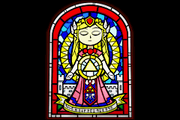
Light Force
Triforce and Light Force would grant unlimited power. However, aside for being represented by triangles and containing the word "force" in their names, there is no known connection between the two powers. This has been dismissed by the creators however.
As written above, according to the Hyrule Historia, the Light Force contains a large amount of the life force found in living beings, similar to the explanation of Force Gems' origin in Phantom Hourglass. From this, it is possible that at the end of The Minish Cap the Light Force dispersed into Force Gems. Alternatively, the Light Force itself may have formed from a concentration of Force Gems. This also supported by how it has the same name in Japanese as the Light Force and the Life Force. Both of these would explain the similar origins of Force Gems and the Light Force, though no further evidence suggests either theory is necessarily true. As the story in Phantom Hourglass mostly takes place in the World of the Ocean King, that could explain the Force Gem's presence there. It should be noted however, that the Force Gems also appear in Spirit Tracks, which implies it actually is a thing in Link's world (and not just the land of Hyrule) as the game itself took place in New Hyrule. Since Carben stated that a Force Gem can be created when someone feels powerful emotions, this further disproves that the Light Force and Force Gems are the same.
Another thing to note, is that Zelda still has at least a portion of the Light Force, which was noted by Ezlo himself. It was also hinted by Ezlo (in the Japanese version) that the amount Zelda has was the reason (along with her kindness) for the miracle the Minish Cap created towards the end. The Light Force is also theorized as the reason for Zelda's natural mystical powers, which is heavily hinted to be hereditary in nature.
Link[]
Reincarnation[]
A common theory as to why each incarnation of Link looks similar and have similar abilities is that they are
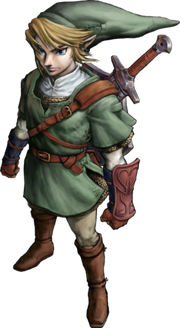
Link
reincarnations of one another. It is notable that when Demise put a curse onto the Skyward Sword, Link, and Zelda, he stated "Those like you... Those who share the blood of the goddess and the spirit of the hero." which may have been referring to reincarnation. It should be noted however, that Link from The Wind Waker could not be the reincarnation of the Hero of Time since the latter went to the Child Timeline and effectively disappeared from the Adult Timeline. According to the King of Red Lions, the Hero of Winds has no connection to the Hero of Time, though it is unclear whether he is referring to blood relation or reincarnation with this statement. It is worth noting that Ganondorf believes the Hero of Winds is the Hero of Time reborn, though his claim has no concrete evidence. Link from Twilight Princess also could not be the reincarnation of the Hero of Time since, according to Hyrule Historia, he not only met the Hero of Time as the Hero's Shade, but is however his descendant.
Relatives[]
Another theory as to why each incarnation of Link looks similar to one another is that they are actually related to one another. This is supported by the fact that the Hero of Time is the ancestor of Link in Twilight Princess as well as how it is stated in A Link to the Past that the Master Sword can only be pulled out from its pedestal by the ones who carry the bloodline of the Knights of Hyrule. It is possible that when Demise stated "Those like you... Those who share the blood of the goddess and the spirit of the hero," when he put a curse on Link and Zelda, he was actually referring to the "spirit of the hero" as a form of will or a set of personality traits rather than the soul itself. If this is the case, this could explain each Link's connection with the Triforce as well as their abilities in physical, mystical, and spiritual ways.
This may mean when he was stating "Those who share the blood of the goddess" he was referring to Skyward Sword Link and Zelda's descendants as the other incarnation of Links rather than the Royal Family of Hyrule, where an alternate reason for the Royal Family having magical powers is the Light Force as hinted in The Minish Cap. This would explain why Link faces other adversaries aside from Ganon, with Zelda (or other members of the Royal Family) sometimes not being present to support the side of good in games such as as Majora's Mask, Link's Awakening and Tri Force Heroes The original Japanese text that Demise states is that his hatred and the Demon Tribe will go under an "evolution", which may mean the curse could involve other villains apart from Ganon himself.
If each Link is related to one another, they need not be related along a single line of descendants. For example, the Hero of Winds cannot be a direct descendant of the Hero of Time since the latter returned to the Child Timeline immediately after his victory over Ganon while being a young preteen in a teenager's body, but provided the Hero of Winds can trace his lineage to Skyward Sword Link, the theory still holds. It is possible that the reason why the Master Sword can only be pulled from it's pedestal by someone who carries the bloodline of the Knights of Hyrule is actually a sub-conscience decision by Fi, who is the spirit of the Master Sword.
Madas[]
It is possible that in the contemporary Hylian language during the events of Skyward Sword, Link's name may be "Madas" when pronounced. This would explain why Fi, when talking to Link in dialogue that uses his name, often says "Madi Madas" with "Madi" possibly being "Master" in the language. Alternatively, it is possible that Fi's words are gibberish used repetitively in the game, similar to Midna in Twilight Princess.
Malon[]
"Oh, it's the fairy boy again! I heard that you found my dad! How did you like the castle? Did you see the Princess? Hee hee! Dad came home in a hurry after you found him. Hee hee! Oh yeah, I have to introduce you to my friend, fairy boy! She's this horse. Her name is Epona. Isn't she cute?"
— Malon
Malon (マロン Maron?) is a recurring character in the Legend of Zelda series. In a majority of her appearances, she and her father Talon are the owners of Lon Lon Ranch, where they raise cows, Cuccos, and horses. Malon also frequently appears in conjunction with the mare Epona as well as "Epona's Song".
Possible Love Interest[]
There has been speculation and heated debate about the possibility of Malon being Link's love
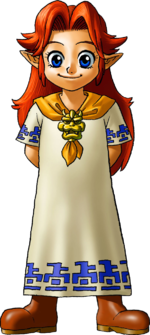
Malon
interest. Reasons include one of the Gossip Stones outside the Temple of Time stating that Malon dreams of a knight in shining armor, Talon joking that Link should marry his daughter, and Malon always seeming cheerful around Link, especially after he rescues Epona. Additionally, Malon is the only female besides Navi in either the supporting or main cast who does not become a Sage, which some interpret as being implied to prohibit relationships; when Princess Ruto awakens as the Sage of Water, she says that she cannot offer Link her love now, as she must guard the Water Temple and he must continue his quest, and when Saria awakens as the Sage of Forest, she tells Link that it is their destiny to live in different worlds, though this may also be a result of Link's aging and true identity as a Hylian. Whether these statements still apply when Hyrule is at peace is unclear. It is also unknown whether any of these characters awaken as Sages in the altered timeline that arises when Princess Zelda sends Link back in time to live out his childhood. In the Hyrule Historia, it is confirmed that the Hero's Shade is the Link from Ocarina of Time and the ancestor of Link in Twilight Princess. Many people take the fact that Link is a rancher in Twilight Princess to slightly imply this theory. Link also happens to know Epona's song, which Malon stated that her Mother sang to her as a baby. It may be that the song was passed down to Twilight Princess's Link as with Malon before him. However, it is possible that Link from Ocarina of Time merely passed down all the songs he knew to his offspring which was passed down all the way to Twilight Princess Link, rather than just Epona's Song. Indeed, Link in wolf form can howl other songs from Ocarina of Time and Majora's Mask in order to meet the Hero's Shade hinting he actually knew them (although this could be because he learned them from the Howling Stones).The subtle hints of Malon's crush on Link also seem to support this theory, but it is still only that — a theory.
Possible Gerudo Ancestry[]
It is possible that Malon's mother is a Gerudo or has Gerudo ancestry as Malon has vibrant red hair and her father, Talon, gives an interesting reaction when Link approaches him while wearing the Gerudo Mask, he will say that it looks like his wife, but then decides against it. If that is the case, that would raise the question on why she wasn't raised as a Gerudo (although this may be because of her differences compared to the other Gerudos).
The Link in The Legend of Zelda: Twilight Princess is a rancher, which could be the result of a relationship between Ocarina of Time's Link and Malon. However, in an interview with Nintendo Power, Eiji Aonuma stated that the Link of Twilight Princess is not necessarily a descendant of the Ocarina of Time Link (although it was confirmed later in Nintendo's official book, Hyrule Historia) Also, Link in no way needs an ancestry of ranchers in order to be one himself.
Masks[]

Deku Shrub Mask

Goron Mask

Mask

Zora Mask
It has been thought that masks in The Legend of Zelda: Majora's Mask could be based off of things from the "real-world". An older coin of New Zealand has a mask that looks somewhat similar to Majora's Mask. Other masks in the game have also been thought to be based off of other things. The Kamaro Mask has been thought to be based off of the Trance Dancer mask, worn by Maori people. The Bremen Mask has been thought to be based off of another Maori mask called the Batik Flame Mask. Other masks and things in the game have also been thought to be based off of Maori masks and items.
Mount Crenel[]
It is possible that Mount Crenel is the same as Death Mountain from other games in the Legend
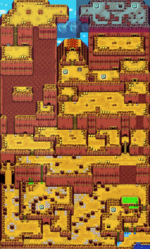
of Zelda series. Facts supporting this theory include the fact that on the Goron Figurine it reveals that the Gorons used to reside on Mount Crenel, but once their numbers fell too few they moved to Goron Cave. There is also an abandoned mine, the Cave of Flames, which is also theorized to be Dodongo's Cavern, the Fire Temple, or the Goron Mines after they became disused once the Gorons moved away. Opposing this theory is the fact that Mount Crenel is shaped differentally than Death Mountain, and has no crater. However, this could be a sign of how mountains change gradually over time.
Mountain Minish[]
The Mountain Minish may be based off of the seven dwarfs from Snow White, or more specifically,

Mountain Minish
the 1937 Disney film adaption. This seems possible since both are groups of diminutive creatures (the Minish being much smaller) that wear similar clothing. Also, both work in mines and sing a special song while doing so. Lastly, there are seven Mountain Minish, not including Melari (Snow White), as well as seven dwarfs.
Multiple Ganon Theory[]
The Multiple Ganon Theory is the theory that there exists more than one Ganon/Ganondorf in the Zelda timeline, in much the same way that Link and Princess Zelda exist as more than one person throughout the Legend of Zelda series. Variations include ideas that Ganondorf is locked in the same cycle of reincarnation as Link, or that Ganon is a malevolent demon who possesses people, Ganondorf being one such host. Supporting the reincarnation idea, it is said by the Gerudo that only a single male is born into their tribe every one hundred years. Depending on the game, he is said to be destined to become either the King of the Gerudo or the guardian of the desert and the Gerudo.
Although the theory has been around for quite some time, most modern versions of this theory stem out of Ganondorf's back-story in The Legend of Zelda: Four Swords Adventures, which conflicts with Ganondorf's back-story in The Legend of Zelda: Ocarina of Time. In Four Swords Adventures the Gerudo talk about a man named Ganondorf who had been born and lived in the Desert of Doubt with them. They mentioned that he had grown into an evil man with a lust for power and had broken their laws by stealing a Trident deep in the desert that gave him incredible powers, such as transforming him into Ganon.
This is in direct contrast to the back-story Ganon was given in Ocarina of Time, in which he is acknowledged by many as the king of the Gerudo, and does not become Ganon until acquiring the Triforce of Power. Additionally, the back-story of The Legend of Zelda: Twilight Princess, which explains the actions of the Ganondorf from Ocarina of Time in an alternate timeline, says that a tribe of thieves, most likely the Gerudo, followed him in his attack on Hyrule, again showing that he was accepted as king.
There are only three logical explanations to these conflicting back-stories:
One is that a single Ganondorf had ventured to the desert and stolen the Trident, broke out of the seal he was placed at at the end of Four Swords Adventures but was not killed by Link, turned back into Ganondorf, and returned to the Gerudo later at a time that they were willing to acknowledge him as king. This would require that Four Swords Adventures take place before Ocarina of Time. The second explanation is that the game is not part of the overall storyline within the series, though official statements indicate that all the games from the main series are included in the official timeline document. The third explanation is that the Ganondorfs from the two games are separate incarnations, much like the many Links, Zeldas, and other characters who are seen multiple times throughout the series. This theory is supported by a quote at the end of Four Swords Adventures in which Princess Zelda calls Ganon an "ancient demon reborn". This is similar language to a line in The Legend of Zelda: The Wind Waker in which Ganondorf calls the game's incarnation of Link "The Hero of Time, reborn". Another solid point for this theory is the apparent death of Ganondorf/Ganon five separate times throughout the series. An individual Ganon is only shown to be resurrected once. Even with this resurrection, and the split timeline allowing a single individual Ganon to die twice, there would still need to be three separate Ganons in order to account for all of the presumed deaths. In order for all of the Ganons in the series to be the same, Ganon would have to have been brought back to life on two additional occasions not hinted at by any of the games, or survived at least two of his apparent deaths.
In The Legend of Zelda: Skyward Sword, Demise states that his hatred will be reincarnated and attack in a cycle without end. This is often interpreted as meaning that Ganon's repeated appearances are a result of this cycle. If Ganon as we know him is a result of Demise's hatred continuously reincarnating itself, there would be further support for the idea that multiple Ganons could continue to appear even as previous ones are slain. This would support the Multiple Ganon Theory as each Ganon would be a separate incarnation in this cycle, though all of them would share the same basic origin of forming from Demise's hatred.
While the Multiple Ganon Theory has yet to gain wide spread acceptance, it has nonetheless gained the respect of some timeline theorist and fans of the series.
Shigeru Miyamoto has stated that although each Link and Zelda are reincarnations, there is "only one Ganon". However, this statement may now be outdated or may have been made based on a lack of information, as Miyamoto is no longer as involved with the Zelda storyline as he previously was.
According to the Hyrule Historia, a second Ganondorf is born during the events leading to Four Swords Adventures. The book either implies or states directly that the rest of Ganon's appearances are the same being brought back to life, or versions of him in alternate timelines.
Postman[]
It is heavily implied that a member of the Rito tribe in The Wind Waker, Koboli, is a
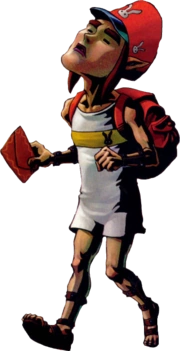
descendant of either the Running Man of Ocarina of Time or the Postman of Majora's Mask. This is due to the obvious similarities in facial appearance. Koboli's occupation also suggests that he is a descendent of the Postman; the text from the Nintendo Gallery explicitly states that he belongs to a family that has been of the mailing profession for generations.
Princess Zelda[]
The relationship Zelda has with Link is close, possibly her closest. A popular theory among
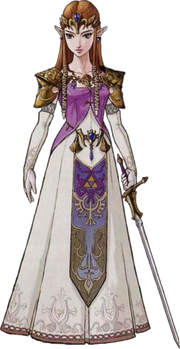
fans is that of a romantic relationship between some of the Zelda and Link characters in the Zelda series. Although never explicitly confirmed in a video game title, this theory is based on hints given in the games, interviews with the game creators, and content of the animated series, comics, and manga (although the last three are generally considered non-canonical).
One hint of a romance between Zelda and Link is given at the end of The Adventure of Link, when the awakened Princess apparently kisses Link under the falling curtain.
Some cutscenes in Ocarina of Time featuring the two together have been interpreted as signs of an attraction. While Link and Zelda are escaping Ganon's Castle, Zelda will additionally show her concern for Link by shouting out whenever he is hurt. Moreover, in the game's final scene, Zelda and Link are floating in the sky together, sharing a decidedly sentimental (if not necessarily romantic) moment where Zelda apologies for involving Link in the events of the game and seems saddened by the situation. She also stated that she will not forget the time she spent with him in the Child Timeline as shown in Majora's Mask through Link's memory.
In addition, if the Oracle games are played as sequels to each other, the ultimate ending sequence shows Zelda lightly kissing Link on the cheek. Link swoons while hearts float above the pair's heads, and Zelda looks away, blushing. In The Wind Waker, when Zelda is asked to stay in hiding in Hyrule Castle while Link restores power to the Master Sword, she waves goodbye to Link, asking him to be careful.
Spirit Tracks features several moments that can be interpreted romantically. Early in the game
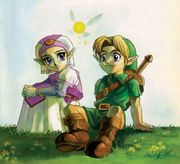
during the Graduation Ceremony, Zelda walks into the room in front of Link, who is bowing down respectfully. Link then looks up and gasps, blushing at her in amazement. He is then scolded by Chancellor Cole for raising his head without permission. Later, when Zelda's spirit is separated from her body following the first encounter with Chancellor Cole and Byrne, Link is the only one who can see her besides the Lokomos, demonstrating a clear and strong bond between himself and the Princess. After Zelda and Link defeat Byrne in the Tower of Spirits, Byrne, disbelieving, comments that he was beaten by two humans. Zelda, while still possessing a Phantom, says that when she and Link combine their strength, no one can defeat them. Link turns to her, surprised. The background turns white and Zelda's Lullaby plays as they both laugh and high-five, gazing at each other all the while. Toward the end of the game, before the final battle against Malladus, Zelda is reunited with her body, and is no longer able to levitate. Link runs underneath her to catch her as she falls, and she lands on top of him and knocks them both to the ground as well as knock Link out for a few seconds. Upon awakening, Zelda, overjoyed to have her body back, embraces Link, causing him to blush. Finally, after Malladus is defeated, Zelda and Link watch Anjean and Byrne's spirits ascend to the heavens. The camera then lowers to show Zelda and Link holding hands while Zelda's Lullaby plays in the background. After the credits, a short cut scene shows Zelda gazing at a picture of Link on the Spirit Train with her flying beside him, which she keeps on her desk. she may also wave at Link depending on his answer to a question Zelda asked before.
Skyward Sword has several noticeable romantic moments between Link and Zelda. Early in the game, Zelda wants Link to be the first to see her outfit for the Wing Ceremony. She worries over him and she does not want him to fail at becoming a knight. When Link's Crimson Loftwing is hidden by Groose, Zelda assists Link in finding his Loftwing. After Link wins the Wing Ceremony, Zelda jumps off the ledge and Link catches her almost as if she was expecting him to. She then congratulates him on winning. Afterwards, Zelda mentions that she is very happy to be atop the Statue of the Goddess with him. She also gets extremely close to him and almost implies that the two are to kiss, before she pushes him off the statue. Afterward, Zelda bashfully asks Link to go out flying which they do. She then tells Link how amazing the day was, and that she would remember it forever. At the Temple of Hylia, when Zelda states she must seal herself to keep Demise in place, she sheds tears of sadness and states before all this, she was happy just being with Link on Skyloft, demonstrating a deep level of feelings for Link. Link desperately tries to stop her and when she is sealed, Link lowers his head in sadness, showing his deep feelings for her. Much later in the game, when Link releases Zelda from her sealed state, Link runs up and catches her from falling and both of them hug and walk out smiling at each other, holding hands, before Ghirahim ruins the tender moment. During the ending, Zelda asks what Link will do now. Link sweetly smiles at her while their Loftwings fly off toward the sky, implying that he chose to stay on the Surface to live with Zelda.
A Link Between Worlds features some gossip told to Link by the Rumor Guy. He tells Link that one of the castle staff had seen Zelda sneaking off every night. When she followed her, she saw Zelda staring at the painting in Hyrule Castle depicting the Link and Zelda from A Link to the Past cuddling with each other, implying they became more intimate with each other. This also hints the Zelda in A Link Between Worlds wants to have a similar relationship with the Link of her time.
The game creators also seem to be fond of the idea of romance between the characters.[1]
Though never directly stated in-game, Shigeru Miyamoto revealed in an interview conducted by Famimaga 64 that Navi is jealous of Princess Zelda and has feelings for Link.[2]
Another less popular theory among fans is that Link and Zelda are related by blood, either as siblings or more distantly. Even though rumors to this effect started with the infamous "Save the Princess... Zelda is your... ... ..." line from A Link to the Past (later reported as a mistranslation), the theory generally revolves around the Link and Zelda from Ocarina of Time.
A possible indication of a blood relation between the two in Ocarina of Time is their physical resemblance: they both have blonde hair, blue eyes, and similar facial features. They also have similarly shaped heads. Graphics limitations could be responsible for some of this similarity, however. Certain dialogue could also be perceived as implying a blood relation: the ghost Sharp comments that Link reminds him of Zelda, and that Link "may have some connection with the Royal Family".[3] Link's connection to the Royal Family is highlighted throughout the game, with Link often playing Zelda's Lullaby to verify it. The fact that Impa agrees to teach a strange boy a song only Royal Family members are allowed to know could also be interpreted as a hint at Link's blood relation to Hyrule's Royal Family. [4]
Additionally, Zelda seems to recognize Link's name upon their first meeting.[5] This could be attributed to her prophetic abilities, although the boy in her dreams seemed to be a largely abstract figure, with no defining traits aside from the presence of a guardian Fairy and a Spiritual Stone. This line of dialogue has often been regarded as a sign that the two have met before, although this could only have occurred when Link was a baby per the Deku Tree Sprout's account of Link's coming to Kokiri Forest. It is also worth noting that while the King of Hyrule is clearly identified as Zelda's father, no mention is made of a Queen. Meanwhile, Link's mother is stated to have died shortly after reaching the forest, but no information is given concerning his father. Given these facts, it is possible that Zelda and Link share the same parents, making them siblings.
Siroc[]
It is possible that Siroc is married to Gregal, as they are the two oldest members of the Wind

Tribe, and all the other members seem to be related.
Split Timeline[]
It is speculated by some that alternate worlds such as the Twilight Realm and Termina may be unaffected by the timeline split. However, while these two realms are alternate dimensions, there is no evidence to support the idea that they exist outside of linear time. Both realms have demonstrated the ability to receive beings from the Child Timeline and return them to the Child Timeline when they exit back into Hyrule. There is no reason to believe that these two realms would only exist as a single timeline, or that they could "prioritize" inputs from one timeline, and later output these into both the timelines.
In addition, the renowned Youtube show, Game Theory, dismissed the Zelda Timeline, particularly the Defeat Timeline (in where Link fails on his quest) on the grounds that "the hero cannot be simultaneously victorious and defeated". Elaborating, he explained that with Link defeating Gannondorf, two perfectly possible timelines are created; However if Link dies at any point in his journey another separate timeline is created. Explaining that the only way for all 3 timelines to exist is the Many Worlds Theory (the theory that all possible pasts and futures exist in separate timelines).
Talon[]
As Malon is confirmed to have been based on Marin, a character from The Legend of Zelda: Link's
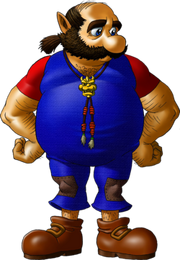
Awakening, it is assumed that Talon is based on Marin's father, Tarin, from the same game. Both are reminiscent in appearance to Mario, and their daughters share many similarities as well.
In The Legend Of Zelda: Ocarina Of Time, Talon gives an interesting reaction to the Gerudo Mask if Link approaches him as a child while wearing it, saying that it looks like his wife, but then decides against it. This reaction hints Malon's mother has Gerudo ancestry. This would explain Malon's vibrant red hair, which appears to be a recessive trait among most Hylians. This has never been confirmed by Nintendo.
Tingle[]
A character named Purlo appears in The Legend of Zelda: Twilight Princess. Purlo is possibly a
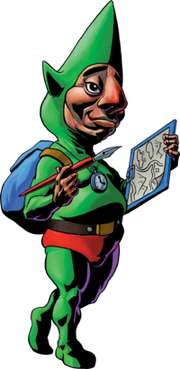
reference to what Tingle would look like if he was a more realistic character. Purlo is the manager of the STAR Game in Hyrule Castle Town, and he wears a similar costume to Tingle. He is also obsessed with Rupees, much like Tingle. Unlike Tingle though, Purlo has an unfriendly attitude towards others.
